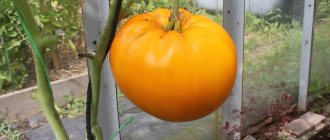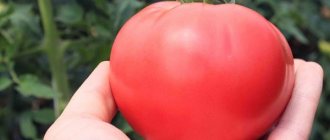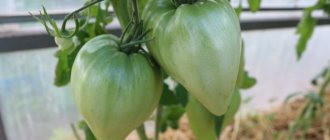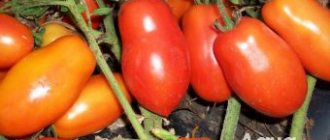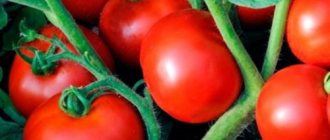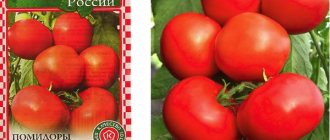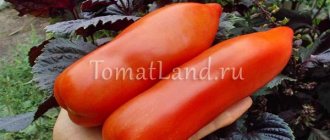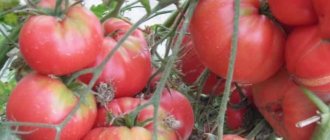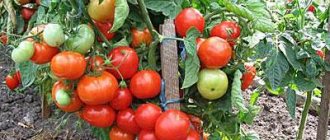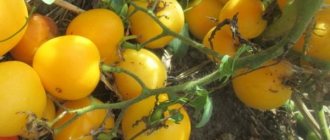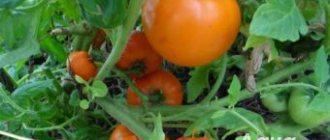The Zimarevsky giant tomato is perfect for both greenhouses and open ground. It was created in Siberia and adapted to the conditions of the cool middle zone - cold nights, drops in temperature. The fruits do not suffer at all from this and remain large, tasty and juicy.
| Height | Landing location | Ripening time | Fruit color | Fruit size | Origin | Fruit shape |
| Tall | Greenhouse, Open ground | Mid-early | Pink | Large | Variety | Flat-round |
Tomato variety Zimarevsky giant
Tomato / 02.15.2019 / Loading...
Despite the fact that tomato is considered a heat-loving crop, there are varieties of Siberian selection adapted to unfavorable conditions.
If you focus on the now fashionable pink large-fruited varieties, then among them you can highlight a tomato called Zimarevsky giant (the name is most likely given in honor of the village of Zimari, which is located in the Altai Territory). The name alone already promises good results.
Our hero is not included in the State Register of Breeding Achievements of Russia, but the reviews about him are very positive. Vegetable growers in cool regions grow this large-fruited miracle in protected ground; in warm regions it can be cultivated in open ground.
Description
The plant is indeterminate, tall, in protected soil the height reaches 2.0 meters, sometimes higher, so towards the end of the growing season you need to pinch the central stem 2 leaves above the upper inflorescence. The bush is strong, with a thick stem. The shoot-forming ability of the tomato is good, the foliage is average.
The leaves are of the usual type, green, medium size. The inflorescences are simple. During the growing season, up to 5 large fruit clusters are formed on the central stem, each containing 5 - 6 fruits.
Tomato growers have noticed that a bush with a truncated top often begins to produce new stepsons with flower clusters, due to this the fruiting period is extended and the yield increases.
The fruits of the Zimarevsky giant are thick-walled, medium-density, flat-round, rather even flattened, with ribbing, especially in the area where the stalk is attached. The skin is medium density, durable, glossy. An unripe tomato is light green, without a dark spot at the stem. When ripe it becomes deep pink.
The pulp is very fleshy, so the variety is classified as Beef tomatoes, tender, juicy, but not watery. There are more than 6 seed chambers. The taste is excellent. Many gardeners have noted the sweet taste. A distinctive feature of our hero is the large size of the fruit.
The usual weight is 300 - 400 grams, but specimens weighing 600 grams often ripen.
Characteristics
- The variety belongs to the mid-early variety. For cool regions, such ripening periods are very suitable, since if properly formed, the tomatoes have time to ripen on the bush, due to which they become even more sugary. Ripeness occurs 100 - 103 days after the appearance of full shoots. True, the weather often interferes with this process, and then you have to wait an extra week for ripening;
- The harvest falls in July - August. But there is information that the plant in the greenhouse continues to form ovaries until the onset of cold weather;
- According to the observations of Siberian agronomists, the yield of the crop is stable and high. The potential yield of the Zimarevsky giant is 10 - 15 kg per 1 square meter. With good agricultural technology, up to 5 kg of fruits are harvested from one plant;
- The variety has high adaptive qualities. Excellent setting is noted even in unfavorable weather conditions. In general, tomato growers speak positively about the plant’s load and its ability to show good set, regardless of the growing region;
- immunity is average, there is high resistance to fusarium wilt. But in unfavorable years, the variety may suffer from Alternaria and late blight;
- transportability is not very high, the fruits are heavy and not too dense, so dents often remain on the surface. During harvesting and harvesting, it is worth taking maximum care of the tomatoes to preserve their appearance;
- keeping quality, unfortunately, is insufficient. Tomatoes must be quickly used for food or processed;
- method of use is universal. First of all, tomatoes are used in their natural form, used in salads, and as a decoration for sandwiches. A large harvest that was not eaten can be successfully processed into tomato products - juices, sauces. The Zimarevsky giant is not suitable for whole-fruit canning.
Agricultural technology
The variety is grown in seedlings. Given the wide geography of regions available for cultivation, it is best to calculate the time for sowing seeds yourself. So, climatic features can be taken into account, and growing conditions - open ground or closed. In the phase of 2 - 3 leaves, the seedlings dive. At the age of 60 - 65 days, the seedlings are ready for transplanting.
Allocate a place for growing that is as bright as possible, this is important. Tomato bushes must be tied to a trellis and formed into 1 - 2 stems. Stepping is carried out as necessary. The recommended planting density is 3 plants per 1 square meter, but not more than 4.
In order for the maximum number of fruits to form in the clusters, during flowering the flower cluster should be periodically lightly shaken, thus improving pollination. In closed ground this is a necessary condition. Agricultural technology is common for the crop as a whole. The soil should not dry out, but it should also not be over-moistened.
Fertilizing is required; complex mineral fertilizers are suitable for this. Do not neglect preventive treatment against diseases and pests.
The Zimarevo giant is a very generous plant, and at the same time quite unpretentious. With fairly easy farming techniques, the vegetable grower can expect a good harvest of tasty and meaty tomatoes. A big plus of the variety is its adaptation to cool climates. The harvest can be used in its natural form or processed. There are also some minor shortcomings.
The plant needs preventive treatment; it needs to be tied up and shaped. In addition, the fruits are not shelf-stable and are not used in whole-fruit canning. But the variety is very interesting, hardworking, for which many tomato growers respect it.
Moreover, the quality of the seed material can be controlled independently by selecting the most beautiful and largest tomatoes.
Share with your friends:
mid-early
Source: https://sortoved.ru/tomat-pomidor/sort-tomata-zimarevskij-velikan.html
Selection of seedlings
For seedlings, you should choose specimens 45–65 days old with 5–7 leaves
When purchasing, you should pay attention to the following:
- plants should have a thick, strong stem and green leaves, well-developed roots;
- seedlings should not be too elongated (no more than 30 cm);
- excessively green color and curling leaves are a sign of abuse of nitrogen fertilizers;
- You cannot buy seedlings with bare roots, without a clod of soil. It is best to take it in a container with soil, and the tomatoes should not grow in a bunch;
- plants must be free of damage, stains, curled or deformed leaves;
It is not recommended to buy lethargic or yellowed seedlings; If you bought seedlings with an ovary, it is better to pick them right away, they will fall off anyway. It is best to choose plants for planting before flowering and ovary formation; you should look under the leaves of tomato seedlings to make sure there are no pests; do not buy seedlings from several different sellers - in this case, the risk of introducing diseased plants into your plot increases greatly.
Did you know? Introduced from the American continent in the mid-16th century, tomatoes were grown by exotic lovers as ornamental plants and were considered inedible. The Portuguese and Spaniards were the first to prepare them at the end of the 17th century. In the Russian Empire, the plant was grown for a long time as an exotic crop, until the seedling method was introduced and the fruits began to reach maturity.
Canadian giant tomato
I'm not a tomato fan. Every year I grow a minimum of varieties: early, late and one for testing. And that’s hard! And if there are a dozen varieties, this is hellish work, and I can only admire and... sympathize with such people.
For example, the Red Giant variety never leaves my garden. I love it for its high taste and appearance, and also because the price for it is always high on the market. This variety makes excellent salads and excellent juice.
In order for the tomato to have a marketable appearance and be large, I’m wise and I’ll do it slowly.
The best varieties of tomatoes
When there are two clusters of fruit on the bush, and the bush has grown to a meter mark, I carry out chasing: with pruning shears I trim the entire row to a “comb” - Then the roots already work only for the fruits, and they turn out excellent! For the sake of quality, you have to sacrifice quantity, but at least the tomatoes are for exhibition!
I have one more technique, I call it a vaccination. Although, in principle, this is the merging of two bushes with the subsequent pinching of one of the two stems.
I take two bushes of seedlings (at any age, when I have free time), grown in cups. In the upper part of the stem I find the most flexible place and with a new blade I make a flat (small cut) - 25-30 mm, cutting off the bark and capturing a little of the pulp of the stem.
On the second plant there is exactly the same bald spot, the main thing is that they coincide when connected. I connect the flats and tie them, like a bandage, with a strip of plastic film 8-10 mm wide. A week later I pinch out the weaker bush. It turns out one plant on two roots.
After a month, the film can be removed, or you can bandage it again, but weakly - just to be on the safe side.”
I plant tomatoes in two waves: the first ones are already leaving, and the second ones are starting to ripen. I also plant two seedlings in a hole: if one destroys the mole cricket, the second will survive, and it’s also more convenient to graft them.
I plant at a distance of no more than 10 cm. In those holes where there are two bushes left, I make sure to connect them, thereby doubling the Vitality of the bush. The principle of grafting is the same as for seedlings in pots.
This method is good because, as I already said, the fruits are excellent, and most importantly, you can save space, which is especially important for summer residents, Pavel SLIPICH, Kherson
Tomato Zimarevsky giant: reviews, photos, yield
We are accustomed to the fact that a tomato bush usually reaches a height of eighty, ninety, one hundred centimeters. Fruits - 150 grams each. Sometimes more, sometimes less. The average yield per bush is 1.5-2 kilograms.
But the usual in this case did not satisfy me. I tried both those varieties and these... They grow and bear fruit. It's not the same.
Once I learned about the amateur gardener Alexander Vasilyevich Tsaregradsky. He lives in the Ivanovo region. Experimenting. His most interesting work is a tomato, to which he gave the name “Giant”. The height of the bush is up to two meters. The fruits are large - 600-800 grams. The yield per bush is from 17 to 20 kilograms.
But I’m not retelling an article about Alexander Vasilyevich, I’m reporting on those specimens of the Giant that have taken root in my garden.
The Giant liked the local land and the southern sun. Now in our area this variety is not a curiosity. Many hobbyists breed it. And they all liked it.
The Giant fruits have less acid and more sugar than our other old-timers. They are less watery and have almost no seeds.
The Giant is good for everyone. One thing is bad: the fruits are unsuitable for transportation - they are too large.
There is another tomato growing in the garden. Brazilian. Its bush is even more impressive than the Giant’s bush—it rises to a height of up to three meters. And the harvest, if you take the shaft, is more substantial: it is quite possible to remove 25 kilograms from a bush. The fruits are red, glossy, oval, very tasty, without tomato acid. And the fruits themselves are small: 100-125 grams.
The Brazilian tomato has another significant advantage: its fruits are very well preserved. Picked green in late autumn, they ripen indoors and last until January.
Along the way, I’ll give you some tips: it’s best to sow Brazilian tomatoes in early February. Seedlings should be transplanted into the ground at the end of April. Before planting, nitrogen-potassium fertilizers are applied. A post is strengthened near each bush, to which the plant is tied as it grows. It’s good to plant garlic nearby: it repels pests.
In addition to Brazilian ones, there are also Mexican tomatoes. They are easy to distinguish: they grow in small cases. Such lucky ones are born in shirts...
This plant is not striking either in the size of the bush or in the size of the fruit. The bush is small, and the fruits weigh about fifty grams on average.
The growing season for Mexican tomatoes is 80 days. Compare: ours have 112. Thirty-two days difference. There is hardly any need to prove how beneficial this is. Well, what do they taste like? Very, very mediocre.
What then attracts small Mexican tomatoes? Gelling agent - pectin. Add twenty percent Mexican tomatoes to ordinary jam and you will get a mass so thick that you can cut it with a knife. Essentially, you will already have marmalade.
Another variety of tomatoes is currant. The fruits are no larger than an ordinary cherry. They grow like currants, that is, on one branch there are 9 pieces on one side and the other. Taste like regular tomatoes.
This tiny, toy vegetable is very popular with children.
Tomato "Red Giant": a productive and productive variety
After all sorts of questioning, reasoning, and looking at it, they eat it with great joy. There are fewer fruits, and the guys are in a better mood. The compensation, in my opinion, is sufficient.
I cannot help but say a few words about one more variety - yellow-fruited. We are used to tomatoes being either red or pink (it’s not for nothing that we sometimes say about a person: “Red like a tomato”), but this one is yellow.
But it's not just about color. Yellow-fruited tomatoes contain almost seven percent dry matter, red tomatoes only four; water in the fruit juice is 93 and 96 percent, respectively, acid - 0.3 and 0.45, sugar - 4.1 and 1.8... The pulp of yellow-fruited tomatoes is tender, juicy, pleasantly sweet with a slight hint of acidity in taste..
Dacha forum: dacha, garden, vegetable garden, flowers.
Dacha forum: about the dacha, about flowers, about your garden plot
Tomatoes 2021 – 3
Messages: 4225 Registered: 01/28/2015, 20:13 From: Ryazan region. boot Thanked: 7969 times Thanked: 4283 times
Status: Offline
Tomatoes 2021 – 3
Posted by tep » 08/20/2017, 10:37
Melon of the North produced decently sized fruits, in general, 2-3 plants of this variety are enough for a family of 4 people, we don’t have time to eat them, and they are not suitable for processing, so next year I will plant smaller ones.
Messages: 6544 Registered: 04/23/2010, 06:00 From: Moscow Thanked: 1289 times Thanked: 1932 times
Status: Offline
Tomatoes 2021 – 2
Posted by Songbird » 08/20/2017, 11:03
Status: Offline
Tomatoes 2021 – 2
Posted by grawicapa » 08/20/2017, 11:36 am
Messages: 12718 Registered: 03/19/2010, 16:39 Interests: Various From: Moscow Northern Administrative Okrug Dacha for Istroi Thanked: 5530 times Thanked: 8791 times
Status: Offline
Tomatoes 2021 – 2
Message from Kuzinamama » 08/20/2017, 11:44
Champion 2009 Messages: 14052 Registered: 03/11/2008, 13:51 From: St. Petersburg Thanked: 7199 times Thanked: 5963 times
Status: Offline
Tomatoes 2021 – 2
Posted by masleno » 08/20/2017, 11:50
Messages: 12718 Registered: 03/19/2010, 16:39 Interests: Various From: Moscow Northern Administrative Okrug Dacha for Istroi Thanked: 5530 times Thanked: 8791 times
Status: Offline
Tomatoes 2021 – 2
Message from Kuzinamama » 08/20/2017, 12:03
Moderator Messages: 14380 Registered: 01.11.2011, 13:20 Occupation: Enjoying life From: Nizhnevartovsk Khanty-Mansi Autonomous Okrug, May 9 Thanked: 5869 times Thanked: 10007 times
Status: Offline
Tomatoes 2021 – 2
Message from Kim » 08/20/2017, 12:04
Catch up, bring joy and do good!
Messages: 6544 Registered: 04/23/2010, 06:00 From: Moscow Thanked: 1289 times Thanked: 1932 times
Status: Offline
Tomatoes 2021 – 2
Posted by Songbird » 08/20/2017, 12:57 pm
Messages: 12718 Registered: 03/19/2010, 16:39 Interests: Various From: Moscow Northern Administrative Okrug Dacha for Istroi Thanked: 5530 times Thanked: 8791 times
Status: Offline
Tomatoes 2021 – 3
Message from Kuzinamama » 08/20/2017, 14:39
Messages: 173 Registered: 06/10/2015, 12:28 From: Rostov region. Thanked: 126 times Thanked: 145 times
Status: Offline
Tomatoes 2021 – 3
Posted by KERRY » 08/20/2017, 04:13 pm
Messages: 16040 Registered: 04/30/2009, 19:43 From: Moscow Thanked: 7999 times Thanked: 11633 times
Status: Offline
Tomatoes 2021 – 3
Message from Anin » 08/20/2017, 16:15
Messages: 6408 Registered: 04/01/2012, 23:25 From: MOSCOW Thanked: 2614 times Thanked: 4036 times
Status: Offline
Tomatoes 2021 – 3
Message from LENIK » 08/20/2017, 17:08
Twice champion 2009 Messages: 3584 Registered: 12/22/2006, 10:05 Interests: from the fence to lunch
https://forum.prihoz.ru/viewtopic.php?p=468037#p468037 Occupation: plumber-san From: Middle East of the Moscow region - Malakhovka Thanked: 1202 times Thanked: 4187 times
Status: Offline
Tomatoes 2021 – 3
Message from AI » 08/20/2017, 18:30
Tomato Zimarevsky giant: reviews, photos, yield
The Zimarevsky giant tomato is a large-fruited variety of Siberian selection. Tomatoes are adapted to cold conditions and can tolerate sudden temperature fluctuations. A tall plant needs special care. Tomatoes are watered, fed, tied to a support.
Botanical description
Description of the tomato variety Zimarevsky giant:
- mid-early maturation;
- height up to 2 m;
- flat-round shape of the fruit;
- 5-6 tomatoes ripen in bunches;
- average weight 300 g, maximum – 600 g;
- stable yield.
The seeds are sold by the Siberian Garden company. The variety is characterized by stable fruiting regardless of climatic conditions. Based on photos, reviews and yield, the Zimarevsky giant tomato is suitable for protected soil.
From 1 sq. m harvest about 10 kg of fruit. With regular care, the yield increases to 15 kg. The fruits are used fresh, processed into paste, juice, adjika and other homemade preparations.
Tomatoes are harvested at the stage of technical maturity and kept at room temperature. Due to the large size and juicy pulp, the shelf life of the fruit is limited.
Planting seeds
Zimarevsky giant tomatoes are grown in seedlings. Seeds are placed in containers filled with soil. Seed germination occurs under a certain microclimate. The strengthened plants are transferred to the garden bed.
Preparatory stage
A substrate is prepared for planting tomato seeds. It is obtained by mixing equal amounts of garden soil and compost. It is allowed to use ready-made soil mixture intended for growing tomatoes.
Before planting tomatoes, it is recommended to disinfect the soil to prevent the spread of diseases and insects. The soil is left until spring at sub-zero temperatures in the refrigerator or on the balcony. Another option is to steam the soil using a water bath.
Tomato seeds are placed in a Fitosporin solution for 30 minutes for 24 hours. Then the planting material is kept for 40 minutes in a growth stimulator solution.
Work order
Planting begins in February or March. In cold climates, seeds are planted at the end of February, in the middle zone - in the first ten days of March. In the southern regions, the landing dates can be postponed to the beginning of April.
The sequence of planting tomato seeds of the Zimarevsky giant variety:
- Containers 10-12 cm high are filled with prepared soil.
- The soil is moistened with warm water.
- Furrows 1 cm deep are made on the surface of the earth.
- Seeds are planted in 1.5 cm increments and covered with soil.
- Cover the containers with plastic wrap and leave in a warm place.
Germination of tomato seeds takes 5-10 days. The film is turned over periodically to ensure oxygen supply. When sprouts appear on the surface, they are provided with good lighting.
Conditions for seedlings
Tomato seedlings Zimarevsky giant provide a certain microclimate:
- temperature during the day – from 18 to 22 °C, at night – not lower than 16 °C;
- regular addition of moisture;
- lighting for 12-13 hours.
Tomatoes are kept on the windowsill. In case of insufficient natural light, special devices are installed. Fluorescent or phytolamps are mounted at a height of 30 cm from the plants.
The soil in the boxes should not dry out. When the tomatoes grow, their stems are hilled to form a strong root system.
After the development of 1-2 leaves, the tomatoes are planted in separate containers. The most powerful plant is left in peat cups.
2 weeks before transplanting into the ground, the tomatoes are taken out onto the balcony or loggia for 2-3 hours. This period is successively increased. Plants adapt to natural conditions, which helps them better tolerate planting in the garden.
Landing in the ground
Zimarevsky giant tomatoes are transplanted to a permanent place in May - June. First you need to wait for the air and ground to warm up.
Tomatoes are transferred to prepared beds in a greenhouse or in the open air. The area should be illuminated by the sun.
The soil begins to be prepared in the fall. When digging, add 5 buckets of humus per 1 square meter to the soil. m, as well as 25 g of superphosphate and potassium sulfate.
After peppers, potatoes and eggplants, the Zimarevsky giant variety is not planted. Replanting tomatoes is possible after 3 years.
After the snow melts, loosen the soil. Before planting, prepare planting holes. A gap of 40 cm is left between the tomatoes. When arranged in a checkerboard pattern, crowding is prevented and plant care is simplified.
The tomatoes are transferred to the pits along with a lump of earth or a peat cup. The soil under the plants is compacted and watered abundantly.
Variety care
For full development, the Zimarevsky giant variety requires regular care. Plants are watered and fed. Tomato bushes are formed to produce large fruits.
The tomato variety Zimarevsky giant is resistant to Fusarium wilt. To protect against diseases and pest attacks, they follow agricultural practices, ventilate the greenhouse, and eliminate excess shoots. For preventive purposes, plantings are treated with biological products. Folk remedies include spraying with garlic infusions and saline solutions.
Tomatoes are watered depending on weather conditions. Excess moisture negatively affects the development of tomatoes and provokes the spread of diseases. When the soil dries out, plants shed their ovaries, their leaves and stems die.
After planting, regular watering of tomatoes begins 7-10 days later. Before the formation of inflorescences, 3 liters of warm water are poured under each bush every 3 days. When flowering, plants require up to 5 liters of water, but watering is reduced to once a week.
After watering, loosen the soil and weed out the weeds. The greenhouse is ventilated to prevent humidity from rising.
Scheme for feeding tomatoes of the Zimarevsky giant variety:
- before flowering begins;
- during the formation of buds;
- at the beginning of fruiting;
- with mass formation of fruits.
Read also: Melon Goldie f1: description and reviews
Slurry is suitable for the first treatment. The fertilizer contains nitrogen, which helps tomatoes increase the number of shoots. Nitrogen substances are used in the early stages of tomato development.
Then the tomatoes are treated with solutions based on potassium sulfate and superphosphate. For 10 liters of water, 20 g of each substance is required. The solution is applied at the root, do not allow it to get on the leaves. A gap of 2 weeks is maintained between treatments.
Minerals can be replaced with organic matter. A day before watering, add 3 cups of wood ash to 10 liters of water. Water the tomatoes with infusion. Wood ash is also incorporated into the soil during loosening.
Shaping and tying
According to the description of the variety, the Zimarevsky giant tomato belongs to tall plants. As they develop, the tomatoes are tied to a support. A wooden peg or thin pipe is driven in next to each bush. The bushes are tied at the top.
It is convenient to tie tomatoes to a trellis. Between the supports, 3 rows of wire are stretched, to which the bushes are tied.
The variety needs pinching. A tomato bush is formed into 2 stems. Excess stepsons are removed manually every week.
Conclusion
Zimarevsky giant tomatoes are valued for their unpretentiousness, large fruits and good taste. The variety is adapted to extreme growing conditions. Tomatoes are grown from seeds that are planted at home. The fruits are used for daily diet and processing. Caring for tomatoes includes watering, adding mineral or organic substances.
Dacha forum: dacha, garden, vegetable garden, flowers
Dacha forum: about the dacha, about flowers, about your garden plot
Tomatoes 2021 - 3
Messages: 3023 Registered: 01/28/2015, 20:13 From: Ryazan region. boot Thanked: 6012 times Thanked: 2782 times
Status: Offline
Growing conditions
Tomatoes are heat-loving plants, and in central Russia, the mid-early variety should be grown in open ground only by seedlings. Seeds germinate at a temperature of +14...+16 °C, and the best temperature conditions for this plant range from 20 to 25 °C. Tomatoes die at the slightest frost, and at temperatures below +14 and above +35 °C they stop forming ovaries. They prefer a day length of 12–14 hours.
The crop is drought-resistant, but to create optimal conditions, you should water the tomatoes after the top layer of soil has dried. The best conditions for tomatoes: when air humidity is between 45–60% and soil humidity is between 65–75%.
Proper watering of tomatoes Good predecessors for the plant are cabbage, cucumbers, root vegetables (except potatoes), legumes and melons. Tomatoes should not be planted after other nightshades. They can only be planted in the area where tomatoes grew after three years.
Tomatoes prefer loamy and sandy loam soils, and with an acidity of 5–6 pH. If the soil is highly acidic, it must be limed every 3–4 years. Heavy clay soil should be dug up with coarse sand (8 kg/1 sq. m), peat (5 kg/1 sq. m), manure, humus or compost (5 kg/sq. m).
Important! When growing tomatoes, you can use organic farming methods - sow peas or other green manure in the fall. In the spring, these plants should be mowed, chopped and embedded in the ground, and after two weeks you can plant tomato seedlings.
An unpretentious plant that produces a huge harvest - the Zimarevsky giant tomato: description of the variety and reviews
The Zimarevsky giant tomato is perfect for both greenhouses and open ground. It was created in Siberia and adapted to the conditions of the cool middle zone - cold nights, drops in temperature. The fruits do not suffer at all from this and remain large, tasty and juicy.
| Height | Landing location | Ripening time | Fruit color | Fruit size | Origin | Fruit shape |
| Tall | Greenhouse, Open ground | Mid-early | Pink | Large | Variety | Flat-round |
Description and characteristics of the variety
The Zimarevsky giant bush is indeterminate and grows up to two meters. The fruits are formed in clusters of 5-6 tomatoes. Their ripening period is mid-early (the first ripe fruits can be harvested 100-103 days after germination of crops). Description of fruits: size reaches 300-600 grams. They have a flat-round shape, fleshy pulp, and excellent taste. The skin is deep pink or crimson.
The fruits are used for salads, making juice, pastes, and adding to dishes. It is inconvenient to preserve such large tomatoes due to their characteristics.
Advantages and disadvantages
Pros:
- Wonderful taste;
- High yield;
- Spectacular large tomatoes;
- Endurance to cold snaps, temperature changes, cool climates;
- Possibility of harvesting seeds.
Minuses:
- Due to their juiciness and soft flesh, tomatoes do not last very long.
Productivity
From 1 sq.m. you can remove 10-15 kg of fruit.
Landing
Seeds are sown 50-60 days before transferring the seedlings to the garden bed. In the middle zone - at the end of March.
Watering
Immediately after planting, you can not water the tomatoes for about a week so that they have time to take root. Then, depending on the weather, water it with warm water at the root. It is better to carry out the procedure in the morning or evening.
Feeding
Feed 4 times a season:
- At the stage of bush development;
- During budding;
- At the beginning of fruit set;
- When tomatoes ripen en masse.
The first feeding is organic, for example, from a mullein solution. Then superphosphate, potassium sulfate or special complexes for tomatoes are added.
Prevention of diseases and pests
The tomato is resistant to fusarium and has good immunity to other diseases. But protection requires prevention. Thus, at the end of summer, the risk of late blight increases, which is caused by temperature changes coupled with increased dampness.
- It is necessary to ventilate greenhouses, and cover tomatoes in open ground during periods of prolonged rain;
- Spray with a solution of wood ash (boil 500 g of ash, dissolve in a bucket of water and add 50 g of laundry soap);
- Maintain crop rotation;
- Control pests and weeds.
Insecticides, soap solution, infusions of garlic, onion, and tobacco will help against parasites such as aphids, slugs, spider mites, whiteflies and others.
You cannot spray the bushes with insecticides during the fruiting period. The Zimarevsky giant tomato is quite easy to care for and not capricious. Gardeners praise its large, fleshy fruits, juiciness and excellent taste, but recommend growing it in a greenhouse.
Source: https://repka.online/ovoshhi/tomaty/srednerannie/zimarevskiy-velikan.html
Landing
To grow seedlings, seeds are sown in March or early April. Check whether the seed is treated with fungicides or stimulants. If the information is not indicated, soak the seeds in a solution of Fitosporin, aloe juice or a solution of potassium permanganate, then rinse.
The soil should contain a lot of organic matter, for example, humus or compost, peat, soil from the garden and drainage. Seeds are placed in grooves up to 2 cm deep at a short distance, moistened and covered with film. Before germination, keep at a temperature of +20–25, then provide cooler conditions and good lighting.
Picking is carried out when the bushes have 1-2 leaves.
Before planting in open ground, seedlings are hardened off for at least 10 days.
For 1 sq. m place 3-4 plants.
Tomato Pink Giant: variety description, photos, reviews
Have you ever planted a Pink Giant tomato ? The description of the variety, photos, reviews found in this article will help you appreciate all the advantages of this popular hybrid. Rest assured, you should pay close attention to it. These tomatoes definitely have something to please you with!
Pink Giant is a heat-loving variety, so it is grown mainly in the southern regions and the middle zone. True, in the second case it is better to use shelter, at least temporary. In the south, farmers and summer residents most often grow it in open ground.
Description and photo of the Pink Giant variety
The structure of the bush. Pink Giant is an indeterminate plant that stops growing only after its growing point is removed. In other words, it is capable of reaching great heights. The bush extends more than two meters above the ground in the greenhouse. In the OG this figure is somewhat more modest.
In the photo there is a tomato bush Pink Giant
Description of the fruits. This point deserves special attention. As you can see in the photo, the fruits of this tomato variety are pink and very large. On one bush, tomatoes of different sizes are formed: from 300 to 600 grams.
Some specimens reach incredible sizes and weigh more than a kilogram. Tomatoes of the Pink Giant variety are fleshy and very tasty. They contain few seeds. How are they used? This tomato is considered a salad tomato, which means it is mainly eaten fresh.
The salads turn out delicious! It also makes an excellent juice or sauce.
Productivity and ripening period. The Pink Giant tomato is considered mid-early, since the moment of fruit ripening occurs 115-125 days after the appearance of the inputs.
As for the yield, it cannot be called very good. With the best care, it is possible to collect about 4 kg from one bush.
This means that when planting three bushes per 1 m² (planting thicker is not recommended), you can actually get 12 kg of giant pink fruits per unit area. This is not the worst result.
In the photo you see a half-kilogram tomato of the Pink Giant variety
Reviews from gardeners about the Pink Giant tomato
The fact that these tomatoes are on the list of the most favorite varieties among gardeners clearly indicates that they have more advantages than disadvantages. We will not cite numerous reviews about this tomato in this article, but we will emphasize the main points that can be gleaned from them.
• There is no debate about the taste of tomato - everyone without exception likes it. • The size of the fruits, in principle, suits everyone, but they force each cluster to be tied up. • Judging by the reviews, farmers agree that the Pink Giant tomato has some protection against diseases.
• Many reviews show dissatisfaction with the fact that, in addition to the low yield of the variety, the bushes also need to be planted far from each other. • Gardeners and summer residents have noticed that tomato tolerates unstable weather conditions and temporary drought.
• Reading the reviews, you will understand that the bushes of this tomato need good support and constant garter. For beginners this can be difficult.
The description of Pink Giant tomatoes says they are resistant to weather changes
Prevention of diseases and pests
The tomato variety “Zimarevsky Giant” has good resistance to Fusarium wilt. To prevent many diseases and the appearance of pests, it is necessary to adhere to agricultural techniques, ventilate the greenhouse, and remove excess shoots. With the onset of warm days with frequent rains, there is a risk of many tomato diseases, including late blight.
To carry out preventive measures, experts recommend the following measures:
- use an infusion of wood ash. To prepare, take 500 grams of ash and boil over low heat in 1.5 liters of water. Then filter and dilute in 10 liters of water, adding 50 grams of laundry soap. The resulting solution is sprayed onto the tomatoes;
- use the drug "Trichopol". Crushed 5-6 tablets are diluted in a bucket of water and 250 grams of milk are poured in. Then the plants are treated with this solution;
- at the first signs of late blight, treat tomatoes with Tattu fungicide according to the instructions;
- To prevent a wide range of diseases and pests, plantings are treated with special biological products such as “Tomato Rescuer”, which is also a growth stimulator. You can also use a solution of Bordeaux mixture or copper sulfate;
- spraying with garlic infusion or salt solution. To prepare garlic infusion, take two glasses of chopped garlic and pour hot water, but not boiling water. Then the infused solution is added to 10 liters and mixed, and then filtered;
- for irrigation it is necessary to use water with a temperature of at least 15 °C;
- Be sure to loosen the tomatoes and apply fertilizer - this will strengthen the tomatoes against many diseases.
Read more about the signs, prevention and methods of combating tomato diseases.
